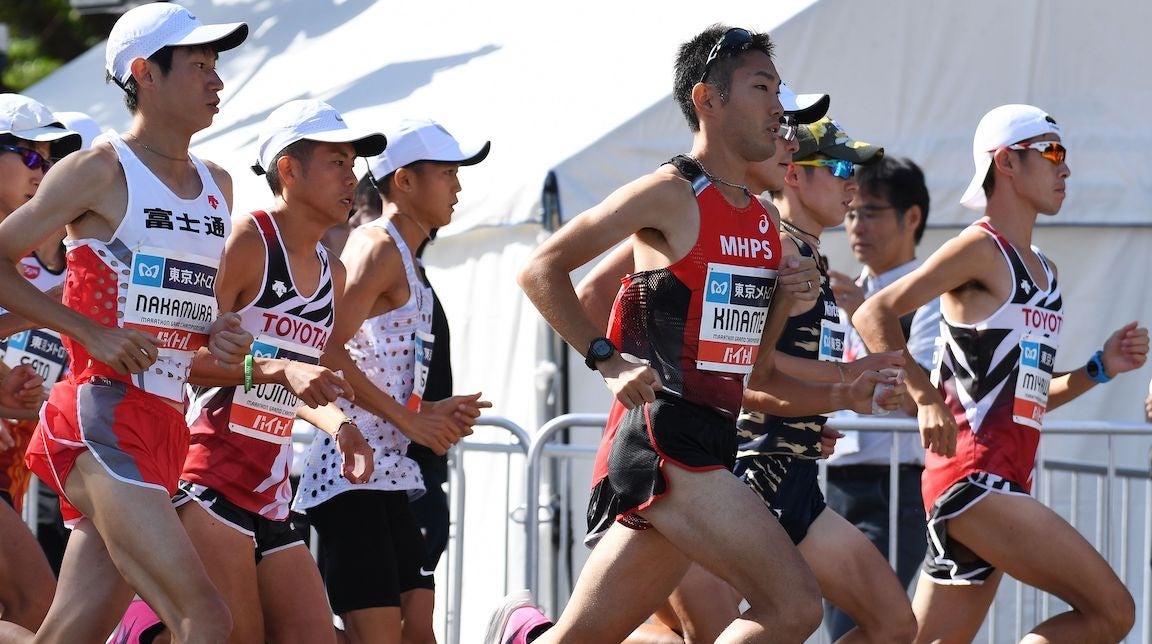Running is steeped in Japanese culture and has been for hundreds of years, dating back to when the courier system during the Edo Period required fit runners to relay important messages up and over treacherous terrain. But of all the distances and disciplines, it’s the marathon that the Japanese love best. Viewership of running events on television and online rivals that of the Super Bowl in the United States. Marathoners like “Citizen Runner” Yuki Kawauchi are hailed as national heroes akin to LeBron James and Peyton Manning.
There are sects of “marathon monks” who, over the course of a 100-day stretch, will cover 52.5 miles daily—twice the length of a standard marathon. From a professional marathoning standpoint, 50 years ago, it was the Japanese—not Kenyans or Ethiopians—who stood atop the Olympic podium.��In 1966, Japanese runners had posted fastest marathon times in the world. In 2001, Naoko Takahashi became the first woman to break the 2:20 marathon barrier in Berlin and as recently as 2017, Kawauchi ran 12 marathons in one year and won this year’s Boston Marathon.
So what is a country nearly the size of California doing right? Are there lessons to learn from many years of running wisdom? You bet. Here are three key secrets of the Japanese marathoning success:
A Rock Solid Aerobic Base
Nobuya “Nobby” Hashizume of the Lydiard Foundation served as an assistant coach for the Hitachi Ltd., Running Team between 1988 and 1991 and says that simply running a lot of mileage—building up a solid base of slower, steady miles—is one critical factor of Japanese success. “The triathlon great, Mark Allen, calls fast, race-specific training ‘sexy’ but the boring groundwork is what really makes you a great marathon runner,” Hashizume says. “Japanese took it to their heart.” Hashizume points out that Takahashi’s former coach, Yoshio Koide, had his runners logging 200 miles a week so that they could close the final 5K of the marathon as fast as possible. Hashizume also recalls that one corporate team coach, the former teammate of legendary marathoner Toshihiko Seko under late coach Kiyoshi Nakamura, had his runners log 60 minutes in the morning, 90 minutes in mid-day and 60 minutes in the evening every day for 4 weeks during the build-up phase. Hashizume calls this kind of running “get-down-and-dirty-on-your-knees” aerobic-base work, and the Japanese have mastered it for decades. “It so happens that the longer the competitive distance, the more heavily we rely on training. So marathoning happens to be one of Japan’s favorite events.”
A Focused Passion for Hard Work
There are no half measures for Japanese marathoners. And where many western elites blame genetic predisposition for not being able to achieve a breakthrough, such thinking doesn’t occur amongst the Japanese professional marathoners. Hashizume quotes coach Nakamura as evidence of this truism: “Natural talent has limits; but there’s no limit to hard work.” Hashizume suggests that Japanese runners still cling to their dreams. “While some young westerners seek some scientific proof whether or not it’s ‘worth trying,’ Japanese still hold, sometimes rather silly old-fashioned ‘romantic’ view that lots of hard work can overcome lack of natural talent.”
Kevin Beck, editor of the book Run Strong, which dedicates a section to the Japanese training ethos bases his conclusions of the Japanese passion from personal observations. “I see groups of elite Japanese women training around the Boulder reservoir and at Fairview High School,” he says. “I don’t know that I’ve ever seen a more focused set of runners anywhere.”
Discipline and Perseverance
Running 26.2 miles as fast as possible requires discipline in all aspects of your life, and the Japanese have this down. Beck calls the Japanese art of perseverance “tireless work and quiet suffering” and says they excel at it. “The marathon is the consummate platform through which [tireless work and quiet suffering] can be expressed beautifully,” he says. “Toshihiko Seko was an over-distance monster known for incorporating not only loads of spectacularly slow running, but walks of 60K or more,” he says. This kind of discipline and perseverance, dealing with the aches and pains and doing “one more” lap or mile is not for runners who want quick results.
Hashizume calls the desire for quick results a “fast-food mentality” in running. “[Some] runners seek bare-minimum to prepare for a marathon, or any other event for that matter,” he says. “Getting into shape is a gradual business. You need to take time to build-up gradually and steadily. You do what you can and the results will follow.”


